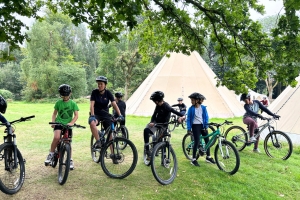High Ashurst activity descriptions
Activities can be adapted for disabled groups. Please find out here more information about our inclusive activities for groups with additional needs.
List of activities available at High Ashurst
Abseiling
Abseiling involves being in control, with assistance, of two ropes descending down a flat wall. Different challenges can be set depending on the confidence of the participant. Challenge by choice will be explained and then one at a time the participants climb the stairs, which are situated inside the climbing tower, and at the top of the tower the instructor will meet them to be clipped in. The
instructor will then explain how the ropes work and step-by-step the participant will be lowered and abseiling will commence.
Archery
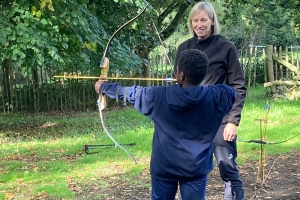
Safety rules are given, followed by an explanation of the bows and arrows and how to shoot, covering standing positions etc. Once the group is clear then one at a time they step up and shoot three arrows with the guidance of the instructor, once they are clear on technique and have all been seen by the instructor, they get a couple of practise rounds and time permitting games may then be played.
Challenge Course
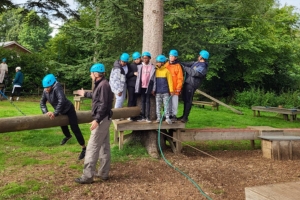
Low level (non harnessed) ropes course, comprising of various team exercises aiming at group cohesion and teamwork development. Thirteen individual elements are linked together in a circular course with the objective of getting round without touching the ground.
Climbing
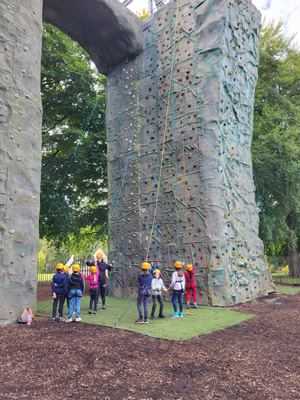
The session starts with some low level climbing, called bouldering or traversing, developing the trust between the climber and their supporting partner, who has to 'spot' the climber to make sure they are in contact with the wall.
Bouldering and traversing is limited to 1 metre. Then the instructor talks the group through ascending and descending the wall using a 'gri-gri' (an assisted braking belay device).
When one person is climbing the rest of the group will be supporting the climber or belaying.
Evening Session
This session runs from 6.30pm to 8.30pm.
During a typical evening session, we'll take a leisurely stroll around the site to learn about the history of High Ashurst and discover some interesting facts about the local nature.
This will be followed by some fun games to get everyone moving before settling down for the night.
We'll then gather around a cozy campfire for a debrief with the instructors to reflect on the day and get ready for what's ahead.
If you have any specific content you'd like to discuss, feel free to chat with your programme lead beforehand!
High Ropes 1

There are 3 Elements - Incline Log, Cat Walk and Trapeze.
- Incline Log walking from ground level up a five metre incline log, turning round at the top ready to run back down the log and experience a "flying" sensation.
- The cat walk accessing the catwalk via a ladder, climbing up onto a horizontal log seven metres high. Walk along the 12 metre log and back to half way, where there are several options, of varying difficulties, to descend.
- Individual trapeze climbing up a ladder to a six metre high platform and jumping from the platform out to catch a trapeze. The trapeze can be moved out depending on the ability of the group.
High Ropes 3
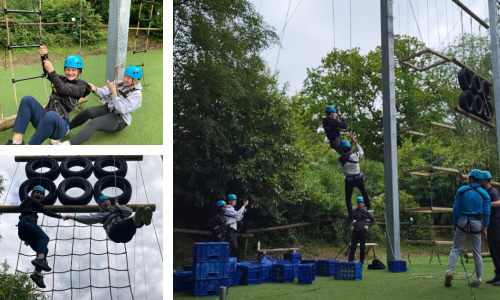
Team orientated task area, comprising crate challenge, Jacob's ladder, all aboard and two-person trapeze.
Where all group members are involved in either the activity or helping with safety by belaying of other members.
- Crate challenge crates are stacked up while up to four group members climb together, as the rest of the group build up the stack.
- Up to four team members tackle the 4 metres wide ladder together offering assistance to one another. As the team progress higher the runs on the ladder get further apart posing more of a challenge as the team develops their technique.
- All aboard up to four team members climb the pole individually and when all members are at the top, holding onto each other, they lean back putting their trust in the other team members.
- Three-person trapeze up to three people climb the pole and wait at the platform for the rest of the participants. When all are there they jump for the trapeze together. The trapeze can be moved out depending on the ability of the group.
Mountain biking
- Practical clothing is a must and an ability to ride a bike is very important.
- Minimum inside leg height is 26 inches.
- Helmets are provided, gloves and glasses are encouraged to be worn.
- Local/Set High Ashurst route and return for bike cleaning and maintenance.
Mountain biking - Group session
- Participants must have basic cycling skills, including the ability to start, stop, and manoeuvre their bike in open spaces and around other cyclists without causing incidents or collisions.
- Non-riders:
- If a non-rider is present, staff will try to accommodate them where possible. However, the main focus will be on ensuring the group of riders has the best experience.
- Non-riders will need to stay at the base during any cycling journeys, and no further cycling instruction or liability will be provided by SOLD.
- The leader must be on a bike.
Mountain Biking - Onsite
- Starting with tuition in basic bike safety checks, moving on to practical application of brakes and gears.
- Skills course to improve and develop technique to discussing what is required for an off site ride.
Mountain Biking - Offsite
- Usually part of a progressive programme, a High Ashurst onsite session must have taken place first to allow instructor to assess suitability of the group.
- Ranges of venues are available such as Headley Heath etc. New areas can be set up.
Orienteering
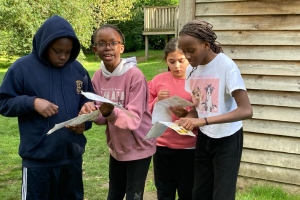
Depending on the ability of the group, orienteering can be started off at many levels, from simple number and compass games to using a fixed post course onsite, and advancing onto participants setting up their own courses and giving them to other members of their group to complete.
This gets the group thinking about drawing maps and greatly builds on map reading skills.
Team Tasks
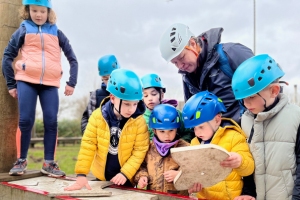
Uses collective knowledge, inventiveness, communication and common sense to achieve success at the chosen and set challenge. In a team of up to ten, an instructor will challenge the group to succeed at a series of problems, mental or physical (sometimes both). The instructor can adjust the game to make it more or less challenging for the group. An ideal exercise to look closely at group
dynamics.
Woodland Skills
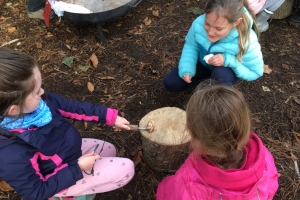
Study the environment and how to best adapt to it. Immensely variable, the sessions focus on survival skills as well as environmental knowledge. Typical woodland skills activities are: fire lighting; shelter building; environmental games; nature walks; Cooking; cordage; tracking or tool use in creating various objects (mallets, pencils, pictures, whistle, key fobs).

